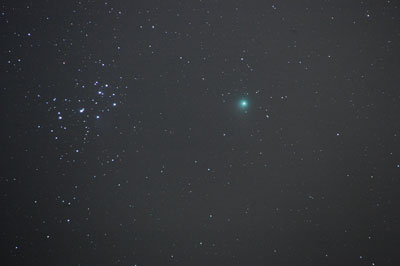Comets are „dirty snowballs“ of ice and rock of several miles or kilometers diameter, which have their origin at the edge of the solar system. When they come closer to the Sun, the ice evaporates, and they leave a trail of gases that points away from the Sun, and a second, less conspicuous dust tail of rock residues, which marks their course. When the Earth passes through the remnants of a dust tail, more meteors than usual can be observed.
Most comets are quite inconspicuous and best observed in a pair of binoculars or a rich-field telescope. As long as they are in the inner solar system, they are quite good to see, but they move very quickly, so they usually can only be seen for a few days or weeks. Then they are either together with the Sun over the horizon in the daytime or are only visible from another part of the Earth. At least after a few months, most comets are already too far away from the Sun to be still bright enough to be visible in binoculars or telescopes. The timespan until they come close to the Sun again ranges between a few years and a few millennia.
Bright comets that are easily visible to the naked eye are much rarer than the inconspicuous ones which are recognizable only in binoculars. For them, a telescope shows even less detail, since only the nucleus with its surrounding gas envelope fits into the field, which shows little detail.

Due to the elongated orbits and the high speed of comets, their appearance is difficult to predict. Path data and finder charts for comets that are within range of telescopes or binoculars can be found in astronomical periodicals as well as on several websites. There is also the path data of the comet (the ephemeris) available for download, so that newly discovered comets can be plotted in your own star map program on a PC or smartphone.
Especially in the past, comets were often discovered by amateurs with larger binoculars or telescopes with a large field of view. Although competition has become stronger now by automatic search systems, if you have a lot of patience and time you still have a good chance to discover a comet. To do this, however, you must know the sky very well, because many, many nebulae and star clusters look similar to small comets – Charles Messier‘s famous list of deep-sky objects arose because he found so many foggy spots during his hunt for comets. It is best to look for new comets at dusk or dawn, when the Sun is still or already below the horizon – many comets are only visible close to the Sun, and here photographic systems are at a disadvantage.
